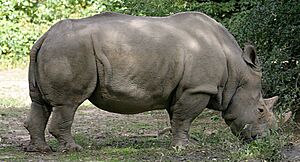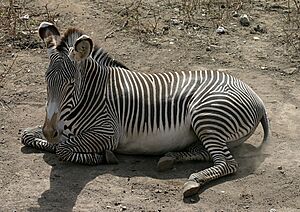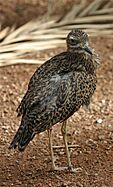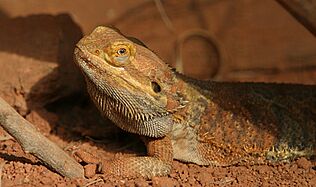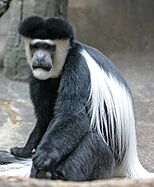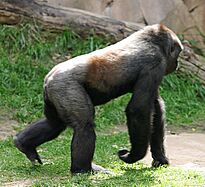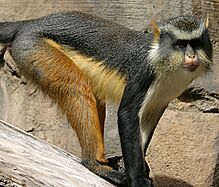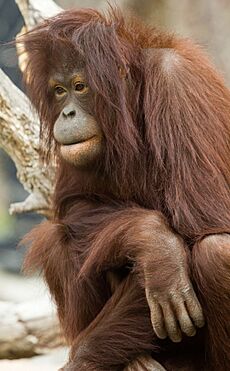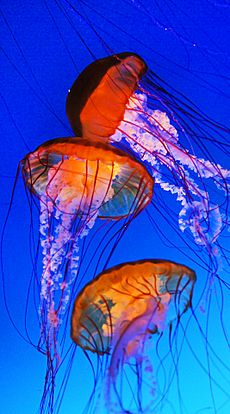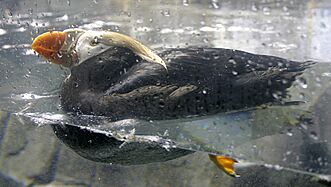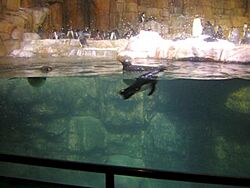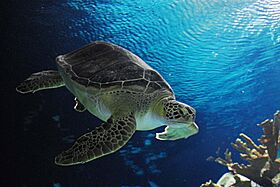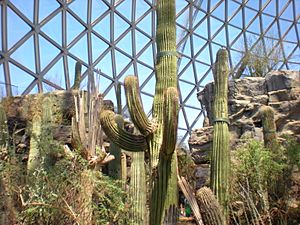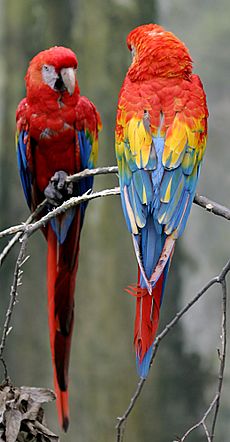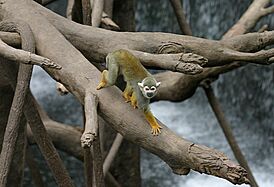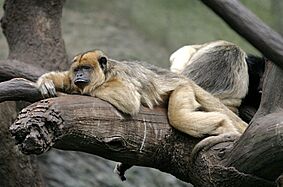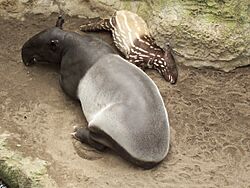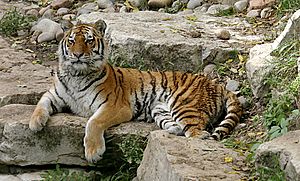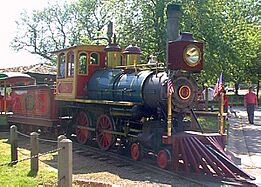Omaha's Henry Doorly Zoo and Aquarium facts for kids
 |
|
| Date opened | 1894 as Riverview Park Zoo |
|---|---|
| Location | Omaha, Nebraska, United States |
| Land area | Over 130 acres (53 ha) |
| Coordinates | 41°13′29″N 95°55′43″W / 41.224703°N 95.928701°W |
| No. of species | 962 |
| Annual visitors | 2+ million |
| Memberships | AZA, WAZA |
| Major exhibits | Lied Jungle, Desert Dome, Mahoney Kingdoms of the Night, Suzanne and Scott Aquarium, Berniece Grewcock Butterfly and Insect Pavilion, Hubbard Gorilla Valley, Hubbard Orangutan Forest, Scott African Grasslands, Asian Highlands, and Owen Sea Lion Shores. |
Omaha's Henry Doorly Zoo and Aquarium is a famous zoo located in Omaha, Nebraska. It is recognized by important groups like the Association of Zoos and Aquariums and the World Association of Zoos and Aquariums. In 2014, TripAdvisor even called it the "world's best zoo"! It was ranked higher than other well-known zoos like the San Diego Zoo.
This zoo is a leader in helping animals and doing important research. It started way back in 1894 as the Riverview Park Zoo. Today, it has many amazing exhibits. "Kingdoms of the Night" is the biggest indoor swamp and nocturnal (night-time) animal exhibit in the world. The "Lied Jungle" is one of the largest indoor rainforests. The "Desert Dome" is one of the biggest indoor deserts and the largest glass geodesic dome anywhere!
The zoo has four main goals: conservation (protecting animals), research, recreation (fun for visitors), and education. These four goals are shown by the four squares in the zoo's logo.
Contents
- History of the Zoo
- Amazing Exhibits
- African Grasslands
- Asian Highlands
- Butterfly and Insect Pavilion
- Desert Dome
- Expedition Madagascar
- Garden of the Senses
- Hubbard Gorilla Valley
- Hubbard Orangutan Forest
- Suzanne and Walter Scott Aquarium
- Kingdoms of the Night
- Lied Jungle
- Owen Sea Lion Shores
- Simmons Aviary
- The Wild Kingdom Pavilion
- Stingray Beach
- Other Fun Areas
- Retired Exhibits
- Conservation Efforts
- Research at the Zoo
- Rides and Ways to Get Around
- Educational Programs
History of the Zoo
The zoo first opened in 1894 as the Riverview Park Zoo. By 1898, it had over 120 animals. In 1952, the Omaha Zoological Society was created to help the zoo grow. The zoo's name changed to Omaha's Henry Doorly Zoo & Aquarium in 1963. This happened after Margaret Hitchcock Doorly gave a large donation. She asked that the zoo be named after her late husband, Henry Doorly. He was an important person who led the World Publishing Company.
The zoo also connected with another famous Omaha company, Union Pacific. In 1968, Union Pacific helped the zoo build 2.5 mi (4.0 km) of train tracks. The first ride on the Omaha Zoo Railroad happened on July 22, 1968.
The zoo has fun rides for visitors. There's a tram and a train that go around the property. You can also ride a carousel. The Skyfari, an aerial tram, opened in 2009. It takes visitors from the Butterfly and Insect Pavilion to the lion exhibit.
The zoo is next to where Rosenblatt Stadium used to be. In 2011, the zoo started turning the stadium land into a new parking area and visitor center. They kept a small memorial where home plate used to be.
Zoo Milestones
- 1894: Riverview Park Zoo opened.
- 1952: The Omaha Zoological Society was formed.
- 1963: The zoo was renamed Omaha's Henry Doorly Zoo & Aquarium.
- 1968: The Omaha Zoo Railroad started, and the Eugene C. Eppley Pachyderm Hill opened.
- 1972: The Owen Sea Lion Pavilion opened.
- 1977: The Cat Complex was added.
- 1983: The Lee G. Simmons Free-flight Aviary was completed.
- 1984: A large saltwater aquarium opened.
- 1988: Construction began on the Lied Jungle.
- 1992: The Lied Jungle opened.
- 1995: The Walter and Suzanne Scott Kingdoms of the Seas Aquarium opened.
- 1998: The Garden of the Senses and the Lee G. Simmons Conservation Park and Wildlife Safari opened.
- 1999: Construction began on the world's largest desert dome.
- 2002: The Desert Dome was finished.
- 2003: Kingdoms of the Night opened beneath the Desert Dome.
- 2004: Hubbard Gorilla Valley opened.
- 2005: The Hubbard Orangutan Forest opened.
- 2008: The Berniece Grewcock Butterfly and Insect Pavilion opened.
- 2009: Skyfari, a chairlift, opened.
- 2010: Expedition Madagascar opened.
- 2012: The Scott Aquarium reopened after updates.
- 2014: Stingray Beach opened, allowing visitors to touch and feed stingrays.
- 2016: Six African elephants arrived from Eswatini. The huge African Grasslands exhibit opened.
- 2018: Bay Family Children's Adventure Trails opened.
- 2020: Owen Sea Lion Shores Attraction opened.
- 2021: Hubbard Gorilla Valley, Expedition: Madagascar, and Hubbard Orangutan Forest reopened after big renovations.
- 2023: An African bull elephant named Callee moved to the Sedgwick County Zoo to help with breeding.
Amazing Exhibits
African Grasslands
The African Grasslands exhibit is huge, covering 28-acre (11 ha)! It cost $73 million and opened on May 27, 2016. This area replaced older exhibits and is home to many African animals.
In 2017, an African elephant named Warren sadly passed away. He was the only male among the six elephants that came from Eswatini. In May 2019, a male African bush elephant named Callee joined the herd of five female elephants to help them have babies. In January 2022, two baby elephants, Eugenia and Sonny, were born! In March 2023, another male calf was born.
Animals you can see here include:
- African bush elephant
- Reticulated giraffe
- Southern white rhinoceros
- Grant's zebra
- Lion
- Cheetah
- Meerkat
- Ostrich
- Okapi
Asian Highlands
The Asian Highlands is a new exhibit that opened in phases in 2018 and 2019. It's an 8-acre (3.2 ha) area that looks like the mountains of central Asia, including parts of India and China. You can walk through it like you're climbing a mountain! There's even a Yeti Camp with themed food and gifts.
Animals in this exhibit include:
- Indian rhinoceros
- Red panda
- Snow leopard
- Siberian tiger
- Sloth bear
- Sichuan takin
Butterfly and Insect Pavilion
The Berniece Grewcock Butterfly and Insect Pavilion opened in 2008. It's a 14,000-square-foot (1,300 m2) exhibit where you can walk right among the butterflies! From above, the building even looks like a winged insect.
Inside, you'll find:
- Butterfly Conservatory: This area has tall glass walls and lots of natural light. It's filled with trees, rocks, and waterfalls to make butterflies feel at home. You can see beautiful butterflies like the blue Morpho and zebra longwing.
- Chrysalis Hatching Room: Here, you can watch butterflies and moths come out of their chrysalis or cocoon. They arrive from all over the world!
- Insect Zoo: This part of the pavilion is home to many different insects and other small creatures. You can see ants, spiders, scorpions, walking sticks, and beetles. There are also exhibits with tropical hummingbirds.
Desert Dome
The Desert Dome opened in April 2002. It cost $31.5 million, which also included the Kingdoms of the Night exhibit below it. It's one of the world's largest indoor deserts, covering about 42,000 ft2.
The Desert Dome shows off different deserts from around the world. You can see features from the Namib Desert in Africa, the Red Center of Australia, and the Sonoran Desert in the United States.
Animals living here include:
- African wild cat
- Bat-eared fox
- Bobcat
- Ocelot
- Cape cobra
- Inland taipan
- Lace monitor
- Laughing kookaburra
- Collared peccary
The Desert Dome is not only one of the biggest indoor deserts, but its geodesic dome is also the largest 'glazed' (meaning it has glass panels) geodesic dome. It's 137 ft (42 m) tall and 230 ft (70 m) wide! The 1,760 clear and shaded acrylic windows help keep the building cool in summer and warm in winter, saving energy.
Expedition Madagascar
Expedition Madagascar opened on May 7, 2010. It features many animals from Madagascar, like lemurs, straw-coloured fruit bats, and giant jumping rats. This exhibit teaches visitors about Madagascar, which is a "hotspot" for different kinds of plants and animals. The zoo's Madagascar Biodiversity Partnership has been working to protect these species since 1998. The exhibit was updated in 2021 and reopened in July 2021.
Animals in this exhibit include:
Garden of the Senses
The Garden of the Senses opened in spring 1998. It's a beautiful garden with many different plants, fountains, and birds. You can also find a giant sundial here.
The garden has over 250 types of herbs, flowers, and trees. There are also plants that attract butterflies. The birds in the garden include colorful macaws and Australian cockatoos.
Hubbard Gorilla Valley
The Hubbard Gorilla Valley is a gorilla exhibit named after Dr. Theodore Hubbard. It opened on April 8, 2004. Before this, it was called the Owen Gorilla House. It had big updates in 2021 and reopened in July 2021.
Some of the animals you can see here are:
- Western lowland gorilla
- Mantled guereza
- Wolf's mona monkey
- Diana monkey
- Abyssinian ground hornbill
- Red River Hog
Hubbard Orangutan Forest
The Hubbard Orangutan Forest opened in 2005. The outdoor part has two tall, artificial Banyan trees that are 65-foot (20 m) high. These trees are connected by vines, and the whole area is covered by a strong netting. Some of the fake vines are even made from old fire hoses! The exhibit had big updates in early 2021 and reopened in July 2021. A 20-foot (6.1 m) waterfall is named after Claire Hubbard, who was a main donor for the exhibit. The indoor area is also very large. The Hubbard Orangutan Forest had more updates and fully reopened in June 2024. This expansion added a new indoor and outdoor exhibit for siamangs, a new elevator, a cafe, and more seating.
Animals in this exhibit include:
Suzanne and Walter Scott Aquarium
The Walter and Suzanne Scott Aquarium opened on April 1, 1995. It's one of the biggest aquariums found inside a zoo anywhere in the world! It was updated in 2011 and reopened on April 5, 2012.
The aquarium shows aquatic habitats from cold polar regions, warm oceans, the flooded Amazon rainforest, and colorful coral reefs. There's a huge 450,000 US gal (1,700,000 L; 370,000 imp gal) shark tank with a 70 ft (21 m) shark tunnel that you can walk through! This tank has sharks, stingrays, sea turtles, and coral reef fish. You can also see different kinds of jellyfish, a Giant pacific octopus, and schooling fish. There's even a touch tank where you can feel starfish and shells.
The aquarium features aquatic animals from all over the world, including:
- Atlantic puffin
- Tufted puffin
- King penguin
- Gentoo penguin
- Sharks
- Stingray
- Green sea turtle
- Jellyfish
- Giant Pacific octopus
- Red-bellied piranha
- Toco toucan
Kingdoms of the Night
The Eugene T. Mahoney Kingdoms of the Night opened beneath the Desert Dome in April 2003. It's the world's largest exhibit for nocturnal animals (animals active at night), covering 42,000 ft2. Together with the Desert Dome, it's a huge 84,000 sq ft (1.9 acres; 7,800 m2) area.
Kingdoms of the Night has different habitats like a wet cave with a deep aquarium, a canyon, an African area, a eucalyptus forest, a dry bat cave, and a swamp. The swamp is also the largest indoor swamp in the world! The logo for Kingdoms of the Night looks like owl eyes.
Some of the animals you can find here include:
- Fossa
- Aardvark
- Naked mole-rat
- Common vampire bat
- American alligator, including a rare white one
- American crocodile
- North American beaver
- Hoffmann's two-toed sloth
- Nine-banded armadillo
- Short-beaked echidna
Lied Jungle
The Lied Jungle opened on April 4, 1992. It's one of the biggest indoor rainforest exhibits in the world! It's inside an 80-foot (24 m) tall building that covers 1.5 acres (0.61 ha). You can even look out from behind a 50-foot (15 m)-tall waterfall.
The exhibit has trails on the jungle floor and walkways above the animals. It was partly closed between 2020 and 2023. As of July 2023, the Lied Jungle exhibit is fully open again. The two levels are divided into sections for animals from Asia, Africa, and South America.
You can find about 90 different species here, including:
- Black howler monkey
- Blue monkey
- Pygmy hippopotamus
- Blue-and-yellow macaw
- Scarlet macaw
- Malayan tapir
- Asian small-clawed otter
- Indian flying fox
- Yellow anaconda
- Arapaima (a huge fish)
- Electric eel
- Philippine crocodile
Ring-tailed lemurs, red ruffed lemurs, and black-and-white ruffed lemurs used to be in the Lied Jungle. They moved to the Expedition Madagascar exhibit when it opened in 2010.
Lied Jungle Awards
The Lied Jungle has won several awards. These include "Single best zoo exhibit in the country" in 1994 by Family Life Magazine. It was also named one of the "Top ten designs in the world" in 1992 by Time magazine.
-
Malayan tapir (with calf)
Owen Sea Lion Shores
The Owen Sea Lion Shores opened on September 4, 2020. This 1-acre (4,000 m2) exhibit replaced older bear and sea lion areas. It has a huge 275,000-gallon saltwater pool with natural wave chambers. There are shallow beaches for young pups learning to swim. Fish feeders release food at random times to encourage hunting. You can also watch the sea lions underwater!
The exhibit features two species: California sea lions and harbour seals.
Simmons Aviary
The Simmons Aviary opened in 1983. It is the third-largest free-flight aviary (bird house) in the world! It's home to about 500 birds from all over the globe.
The Aviary is 800 feet (240 m) long and 75 feet (23 m) tall in the middle. It's covered with 142,000 sq ft (13,200 m2) of special nylon mesh. Using nylon instead of wire is a unique idea for modern aviaries.
In this 4-acre (16,000 m2) exhibit, you can see birds like American flamingos, black crowned cranes, scarlet ibises, and many types of ducks.
The Wild Kingdom Pavilion
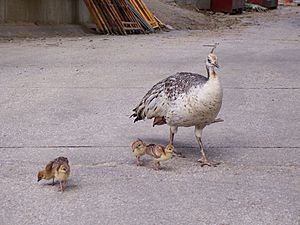
The Mutual of Omaha's Wild Kingdom Pavilion opened in 1987. This 21,000-square-foot (2,000 m2) building now houses reptiles, insects, amphibians, and small mammals. It also has classrooms and an auditorium.
The Wild Kingdom Pavilion has been partly changed into the Exploration Station. This area acts like a "Trail Head" for your zoo adventure. It has an interactive map of the zoo and videos of the main attractions. In the center, there's a 20-foot (6 m)-high netted tree with free-flying birds. Below the tree, you can see water displays with turtles and archer fish. The Small Animal Collection in the building has many different animals like tarantulas, snakes, and hedgehogs.
Stingray Beach
Stingray Beach has a shallow saltwater pool where you can touch and feed three kinds of stingrays: Cownose, Southern, and Atlantic. The area also has green spaces and art.
Other Fun Areas
The zoo also has the Lozier IMAX Theater for movies, Glacier Bay Landing, and a Budgie Encounter in the Adventure Trails play area.
Retired Exhibits
Cat Complex
The Cat Complex opened in 1977. It had 11 indoor and 10 outdoor areas for cats. It was known as the largest cat-breeding facility in North America. The zoo was famous for its work in artificial insemination of big cats. The Cat Complex closed in 2019 and was taken down in 2022. The cats moved to new exhibits like African Grasslands and Asian Highlands, or to other zoos.
The complex used to have nine species of cats, including:
Durham Family Bear Canyon
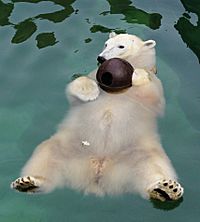
The Durham Family Bear Canyon opened in 1989. It had a large 30,000-U.S.-gallon (25,000 imp gal; 110,000 L) tank for polar bears. It used to house four types of bears: the polar bear, American black bear, sun bear, and spectacled bear. This exhibit closed and was taken down in 2018 to make space for Owen Sea Lion Shores.
Red Barn Park
The Red Barn Park was a petting zoo that opened in 1966. It had many farm animals like goats and cattle. It was known for its big red barn. It was taken down in 2018 and replaced by the Glacier Bay Landing area, which opened in spring 2019. Many of the animals moved to the Children's Adventure Trails.
Conservation Efforts
Amphibian Conservation Area
The zoo's Amphibian Conservation Area opened after a 2005 report said that amphibians (like frogs and salamanders) were the most threatened group of animals with backbones. This special area is behind the scenes, so visitors can't go there. Its goal is to help wild amphibians by improving their care, helping them reproduce, working with other groups, and releasing them back into nature.
This 3,800 square-foot facility has 13 rooms with controlled temperatures. It also has a special water treatment system and strict cleaning rules to keep it free of germs. With only three full-time keepers, this area has helped release over 121,000 amphibians back into the wild!
Amphibian Recovery Programs
The zoo is involved in many programs to save amphibians:
- Wyoming Toad: This toad is almost gone from the wild. The zoo has helped release over 31,000 of them since 1992.
- Western Boreal Toad: This toad's numbers have dropped since 1994. The zoo has released over 3,800 of them since 1995.
- Eastern Hellbender: This giant salamander lives in many states. The zoo helped release 91 of them between 2012 and 2017.
- Puerto Rican Crested Toads: These toads are critically endangered. The zoo has released over 80,000 of them since 1998.
- Mountain Yellow-Legged Frog: This frog is endangered in California. The zoo has released over 800 of them since 2017.
- Dusky Gopher Frog: This is one of the most endangered frogs in the U.S. The zoo has released 792 of them since 2008.
- Amphibian Rescue and Translocation Program: Zoo staff look for native amphibians on the zoo grounds that might be in danger from construction or weather. They rescue and move these animals to safer places. They have released over 3,480 individuals of species like the American toad and eastern tiger salamander.
Research at the Zoo
The Bill and Berniece Grewcock Center for Conservation and Research is a top-notch research center at the zoo. Scientists here have even discovered new species! The world's first "test-tube" gorilla (born through in vitro-fertilization) lives at this zoo. The world's first tiger born through artificial insemination was also born in Omaha in 1991, followed by the first artificially inseminated gaur.
The research center focuses on six main areas:
- Learning and sharing new technology
- Conservation medicine (animal health for conservation)
- Molecular genetics (studying animal DNA)
- Reproductive physiology (how animals reproduce)
- Horticulture (plant science)
- Nutrition (animal diets)
Mouse Lemur Discoveries
A study led by Edward Louis, a scientist at the zoo, found three new types of mouse lemurs. One of them was named after Lee Simmons, the zoo's director.
Rides and Ways to Get Around
Zoo Railroad
The Omaha Zoo Railroad is a 2.5-mile (4.0 km) long train ride that goes around the zoo. It started running on July 22, 1968. The train uses one of two oil-powered steam locomotives. Riva is a powerful engine used on busy days. The #119 is the zoo's original locomotive. A new diesel locomotive arrived in 2008 for moving passenger cars.
Tram
The tram is a train-like vehicle that drives on the zoo's paths. It has four stops around the zoo, making it easy to get around.
Skyfari
The Skyfari is an aerial tram (like a chairlift) that opened in 2009. It takes you from the Butterfly and Insect Pavilion to the lion platform. You get amazing views of the African veldt (where ostriches and giraffes live), cheetahs, and lions from above!
Carousel
You can ride handcrafted animal figures on the carousel. In 2021, it moved to the Glacier Bay area after it was updated.
Educational Programs
The zoo offers many educational programs. These include classes for preschool and high school students, internships, and volunteer opportunities. They also have field trips, guided tours, workshops for teachers, and animal presentations. You can even have overnight campouts, scouting events, summer camps, and birthday parties at the zoo!




